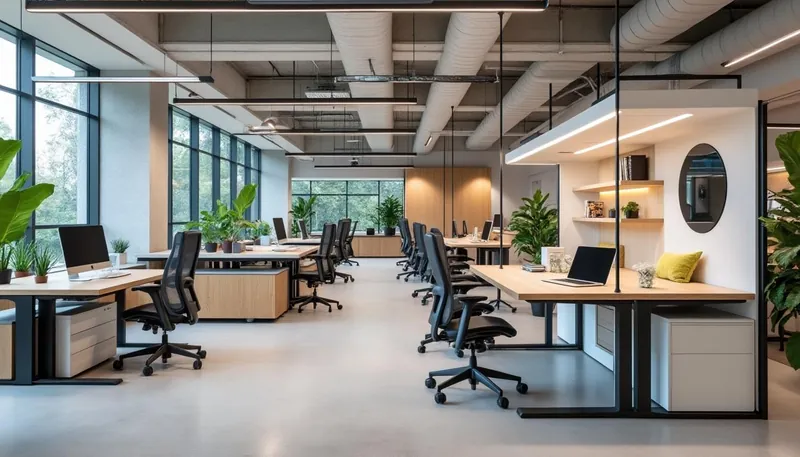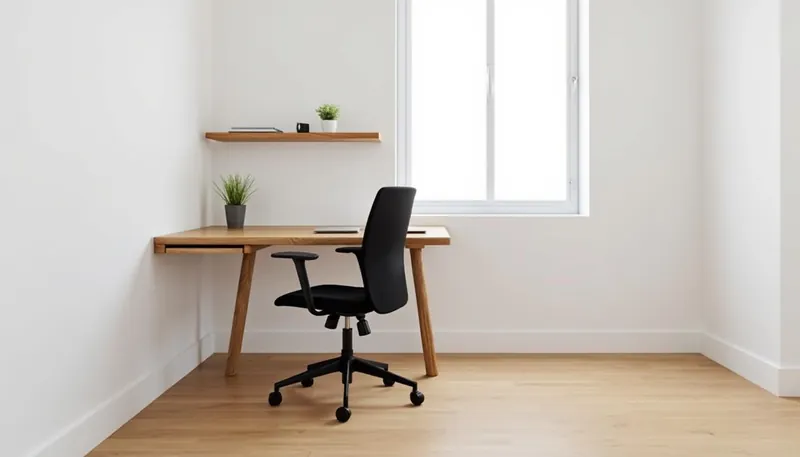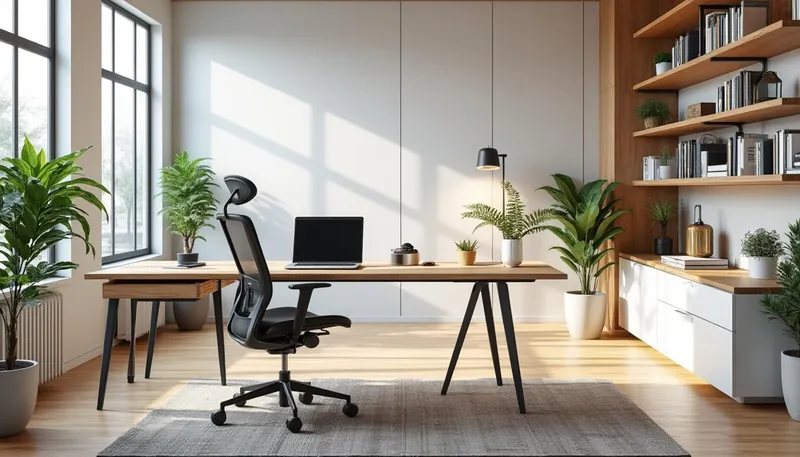The importance of a well-designed workspace has become even more evident in today’s fast-paced business environment. A significant 83% of companies now aim to bring employees back to the office, recognizing that an inviting, thoughtfully arranged workplace can influence attendance and morale. Even if the office is limited in size, effective design can create a welcoming ambiance that attracts employees. The way we design small office spaces can directly impact our productivity and creativity, underlining the value of maximizing every inch of square footage available. Like a magician pulling a rabbit from a hat, smart design choices can transform cramped areas into functional, inspiring workplaces. Whether you’re managing a start-up or simply working from a compact home office, let’s explore how to maximize your workspace with creativity and intention.
Brief
- Choose multifunctional furniture to enhance space efficiency. 🪑
- Incorporate breakout areas for relaxation and collaboration. ☕
- Embrace minimalist design for an uncluttered environment. 🎨
- Utilize smart lighting solutions to create an open atmosphere. 💡
- Implement strategic storage solutions to keep the space organized. 📦
Choosing the Right Furniture for Your Small Office Space
When managing a small office, the type of furniture you choose plays a pivotal role in maximizing your space. The objective is to select furniture that is not only functional and stylish but also compact enough to prevent the area from feeling congested. Multifunctional furniture becomes an essential ally. For instance, consider using desks that double as storage units or modular seating that can be reconfigured as needed. Brands like Ikea, Herman Miller, and Steelcase offer innovative solutions that combine practicality with design.
Additionally, vertical storage is a game-changer in small spaces. Utilizing tall bookshelves and wall-mounted racks can streamline your office while reducing clutter. Keep in mind that furniture arrangements shouldn’t be pressed against the walls, as this can make an office feel boxed in. Instead, placing your furniture strategically can enhance the flow and functionality of the space. Here’s a list of ideas to consider:
- 💺 Tables that can be folded away when not needed.
- 🛋️ Seating that doubles as storage, like ottomans.
- 📚 Wall-mounted shelves to eliminate floor-bound furniture.
- 🖥️ Desks with built-in organizers to cut down on visible clutter.
- 🔄 Use modular systems that can easily adapt to changing needs.
| Furniture Type | Functionality | Style |
|---|---|---|
| Folding Tables | Easy storage | Modern |
| Convertible Sofas | Seating and sleeping | Chic |
| Wall Shelves | Vertical storage | Minimalist |
| Ergonomic Desks | Health benefits | Professional |

While the right furniture can help you maximize the utilization of your space, it’s equally important to choose pieces that resonate with your office’s overall vibe. For instance, warm tones can create a more inviting atmosphere, while cooler tones may promote calm and focus. A touch of greenery, such as potted plants, can enliven the environment while also improving air quality. It’s all about finding the balance that best suits your team’s culture and workflow.
Creating Breakout Spaces in a Small Office
As work dynamics evolve, having designated breakout spaces within small offices provides an essential balance of collaborative and personal work avenues. Breakout rooms offer informal gathering spots, lending a relaxed vibe to meetings and enhancing communication among team members. They can also function as informal lounges where staff can take a breather or brainstorm ideas. The size of the breakout space isn’t the paramount factor; clever arrangements can create distinct zones even in limited areas.
Implementing a hybrid workspace approach, where certain parts of the office are dedicated to brainstorming sessions and relaxation, becomes fundamental. You might integrate soft seating with sturdy coffee tables or create quiet nooks with acoustic panels for those needing uninterrupted focus. Here are some points to consider:
- 🥤 Provide a coffee machine for breaks.
- 🛋️ Use flexible seating arrangements that can be reconfigured.
- 📅 Encourage short meetings in casual settings without formalities.
- 🎶 Add background music to cultivate energy during discussions.
- 📥 Ensure adequate storage for supplies to avoid clutter in breakout zones.
| Breakout Space Feature | Functionality | Recommendation |
|---|---|---|
| Informal Seating | Relaxation | Couches from West Elm |
| Coffee Station | Refreshment | Add a compact unit from Container Store |
| Sound Panels | Noise reduction | Fabric panels from Muji |
These breakout areas, while small, can become significant in providing spaces where employees feel free to collaborate and innovate. The key to success here lies in creating environments that foster creativity while still providing the much-needed escape from traditional work setups. Therefore, understanding your team’s dynamics can inform these designs, making the right choices simple and straightforward.
Embracing Minimalism for Small Office Design
Minimalism is not just a trend; it’s a powerful design philosophy that speaks volumes in small office settings. A more streamlined approach allows for less clutter and greater focus. By emphasizing function over form, minimalism creates an atmosphere conducive to productivity and reduces distractions. The simple act of decluttering can have a profound impact on employee mood and performance. Remember, a clean space is a happy space!
Light colors and essential furnishings can promote a sense of openness in smaller offices. Think of using whites, soft greys, and beiges to make the environment feel airy and brighter. In addition to color, the strategic choice of decor plays a role in retaining the minimalist aesthetic while adding a personal touch. Here’s how to implement minimalism:
- 🌼 Keep decor simple with a few well-placed plants.
- 🖼️ Choose artwork that adds personality without overwhelming the space.
- 🗃️ Only display necessary items on your desk; limit personal items.
- ⚪ Opt for a monochromatic aesthetic with splashes of color for vibrancy.
- 🔄 Use furniture that can be easily moved or repurposed.
| Minimalist Design Element | Purpose | Suggestions |
|---|---|---|
| White Walls | Enhances light | Combine with vibrant art |
| Compact Desks | Maximize area | Uplift Desk for versatility |
| Open Shelves | Organized storage | Use decorative baskets for aesthetics |

Incorporating minimalistic design principles can profoundly change the dynamics of your workspace. Not only does it improve aesthetics, but it can also enhance employee wellbeing. Creating a light and clutter-free workspace provides a fresh canvas for creativity and innovation, ensuring that your office promotes both style and productivity.
Light, Space, and Storage: The Triple S of Small Offices
Designing small office spaces without considering lighting, ambiance, and smart storage solutions is like baking a cake without the cake! Lighting is crucial as it not only brightens up the office but also influences mood and productivity. Harnessing natural light is ideal, so placing desks near windows can have a massive payoff. In addition to this, quality artificial light can help fill any gaps left by daylight.
Storage solutions need to go hand in hand with proper lighting. Using wall-mounted units, pegboards, and vertical file holders can significantly enhance space organization while ensuring that items remain easily accessible. Here’s a rundown of how to get the balance right:
- 🌞 Use curtains that allow natural light but can block glare.
- 💡 Invest in energy-efficient LED lights to save on electricity costs.
- 📦 Choose multi-functional storage pieces that serve additional purposes.
- 🪞 Integrate mirrors: they bounce light around the space and can create an illusion of depth.
- 📁 Implement systems for organizing cables to keep the area sleek and presentable.
| Lighting Feature | Focus | Recommendation |
|---|---|---|
| Natural Light | Boosts mood | Place desks near windows |
| LED Fixtures | Cost-effective | Use them for overhead lighting |
| Task Lamps | Direct light for tasks | Choose modern designs from CB2 |
Pursuing the trifecta of light, space, and storage not only ensures the functionality of your office but also establishes an environment where creativity can flourish. By gearing your design strategies toward balancing these elements, your small office can transform into a thriving space, where productivity breaks free from the constraints of size.
What are some budget-friendly furniture options for a small office?
Brands like Ikea and Muji provide affordable and stylish furniture that won’t take up too much space.
How can I effectively utilize vertical space?
Install tall shelving units, wall cabinets, or pegboards to keep the floor clear and organize supplies.
What colors should I use to make my office feel bigger?
Light, neutral colors such as whites, greys, and pastels will give an illusion of space and create a calm work environment.
How can I enhance natural light in my office?
Use sheer curtains and avoid placing large furniture in front of windows to allow more sunlight to flood in.
Why is office design important for employee morale?
A well-designed workspace can lead to happier employees, increase productivity, and promote a collaborative environment.


